

Synthesis Essays: A Step-by-Step How-To Guide
A synthesis essay is generally a short essay which brings two or more sources (or perspectives) into conversation with each other.
The word “synthesis” confuses every student a little bit. Fortunately, this step-by-step how-to guide will see you through to success!
Here’s a step-by-step how-to guide, with examples, that will help you write yours.
Before drafting your essay:
After reading the sources and before writing your essay, ask yourself these questions:
- What is the debate or issue that concerns all of the writers? In other words, what is the question they are trying to answer?
- On what points do they agree?
- On what points do they disagree?
- If they were having a verbal discussion, how would writer number one respond to the arguments of writer number two?
In a way, writing a synthesis essay is similar to composing a summary. But a synthesis essay requires you to read more than one source and to identify the way the writers’ ideas and points of view are related.
Sometimes several sources will reach the same conclusion even though each source approaches the subject from a different point of view.
Other times, sources will discuss the same aspects of the problem/issue/debate but will reach different conclusions.
And sometimes, sources will simply repeat ideas you have read in other sources; however, this is unlikely in a high school or AP situation.
To better organize your thoughts about what you’ve read, do this:
- Identify each writer’s thesis/claim/main idea
- List the writers supporting ideas (think topic sentences or substantiating ideas)
- List the types of support used by the writers that seem important. For example, if the writer uses a lot of statistics to support a claim, note this. If a writer uses historical facts, note this.
There’s one more thing to do before writing: You need to articulate for yourself the relationships and connections among these ideas.
Sometimes the relationships are easy to find. For example, after reading several articles about censorship in newspapers, you may notice that most of the writers refer to or in some way use the First Amendment to help support their arguments and help persuade readers. In this case, you would want to describe the different ways the writers use the First Amendment in their arguments. To do this, ask yourself, “How does this writer exploit the value of the First Amendment/use the First Amendment to help persuade or manipulate the readers into thinking that she is right?
Sometimes articulating the relationships between ideas is not as easy. If you have trouble articulating clear relationships among the shared ideas you have noted, ask yourself these questions:
- Do the ideas of one writer support the ideas of another? If so, how?
- Do the writers who reach the same conclusion use the same ideas in their writing? If not, is there a different persuasive value to the ideas used by one writer than by the other?
- Do the writers who disagree discuss similar points or did they approach the subject from a completely different angle and therefore use different points and different kinds of evidence to support their arguments?
- Review your list of ideas. Are any of the ideas you have listed actually the same idea, just written in different words?

Synthesis Essay
Synthesis essay generator.
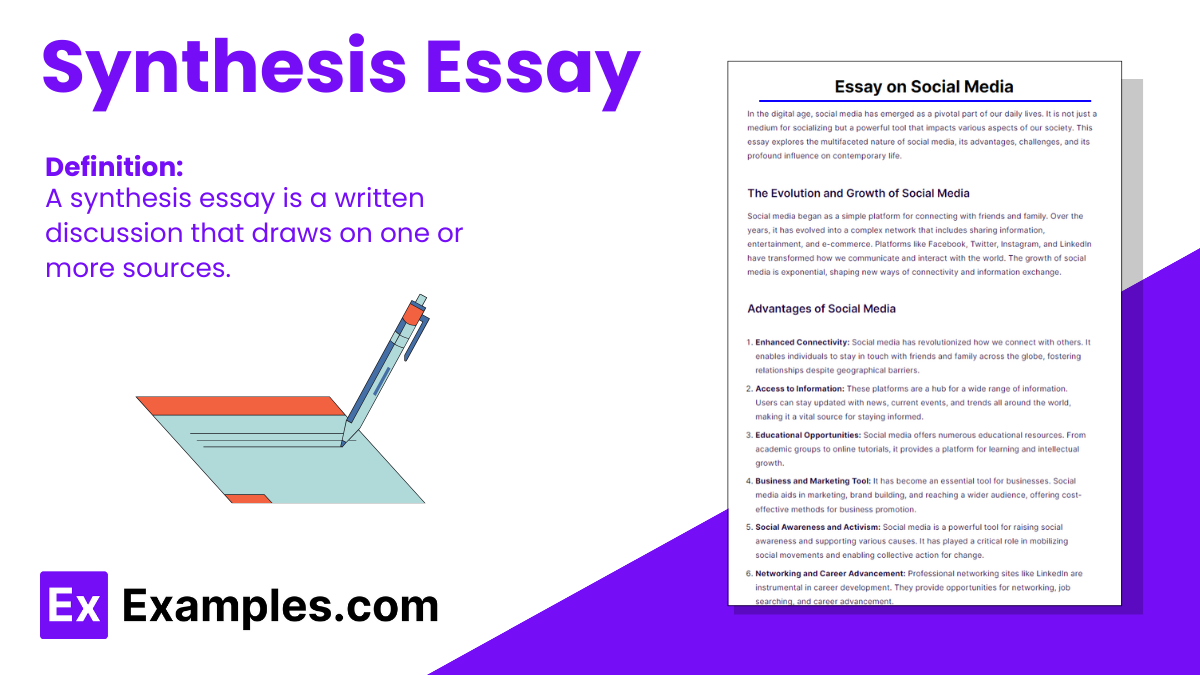
A Synthesis Essay is a sophisticated form of writing that requires the integration of various sources and perspectives. Our resource provides a comprehensive look into this writing style, complete with insightful essay examples . These examples demonstrate how to effectively combine information from different texts, crafting a cohesive and well-argued narrative. Ideal for students and professionals alike, this guide will help you master the art of synthesizing diverse viewpoints into a single, compelling argument in your essays.
What is a Synthesis Essay?
A synthesis essay is a written discussion that draws on one or more sources. It involves combining information from various sources to make a cohesive argument or presentation on a specific topic. This type of essay requires the writer to analyze information, derive insights, and present them in a structured and coherent manner. The key to a successful synthesis essay is not just summarizing the sources but integrating them to create a new perspective or argument. Writers must cite their sources accurately, showing how each piece of information contributes to and supports their thesis or main argument. Synthesis essays are common assignments in academic settings, especially in higher education, testing students’ abilities to research, evaluate, synthesize complex information, and articulate their findings effectively.
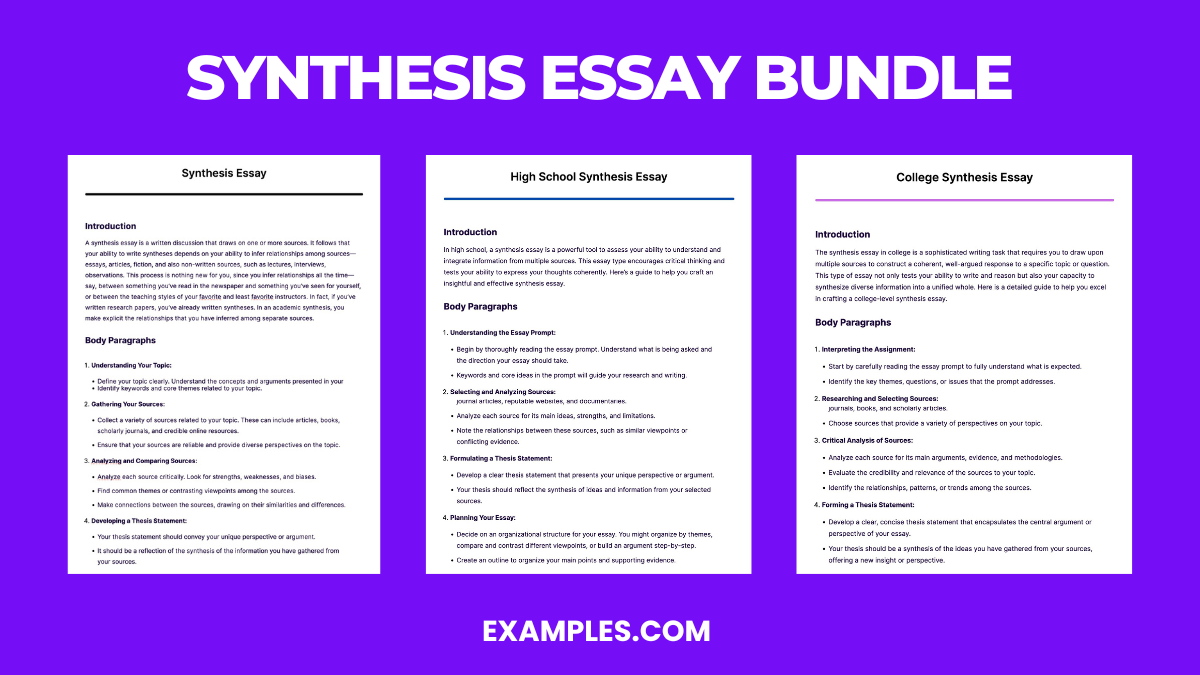
Download Synthesis Essay Bundle
Essays depict the standpoints of a writer on a certain topic or issue. An essay often presents a point and either convinces a reader to agree or disagree to a certain subject matter. An effective essay does what it is intended to do when a reader is convinced of the writer’s stand point. Common college essays include writing a synthesis essay. Examples of synthesis essay can be found in the page and made available for your reference. The examples can also be downloaded via the download link button below the sample in order to get a closer look.
Synthesis involves combining different pieces of information to form a cohesive understanding. For instance, if you gather insights from various experts about the impact of climate change and weave them into a comprehensive article or report, you are performing synthesis. This process is distinct from merely summarizing since it requires critical thinking to integrate ideas and form new connections, rather than just listing details or differences like in comparison and contrast.
Synthesis Essay Structure
It helps in presenting your argument clearly and persuasively. Here’s a typical structure for a synthesis essay:
Introduction
Hook: Start with an engaging sentence to grab the reader’s attention. Background Information: Provide some context or background for the topic you will be discussing. Thesis Statement: Present your main argument or position on the topic, clearly stating how the different sources will support your thesis.
Body Paragraphs
Each body paragraph should focus on a specific point or aspect of your thesis, integrating multiple sources to support each point.
Topic Sentence: Introduce the main idea of the paragraph that supports your thesis. Evidence and Analysis: Include information from your sources as evidence to back up your point. This could be quotations, summaries, or paraphrased material. Analyze the evidence, showing how it supports your argument. Synthesis: Discuss how the evidence from different sources relates to each other and to your thesis. This is where you combine (synthesize) the information to build your argument. Concluding Sentence: Summarize the main point of the paragraph and how it supports your overall thesis.
Counterarguments (Optional)
Consider including a paragraph that addresses potential counterarguments or opposing views. Refute these arguments and show how your thesis still stands.
Summary: Briefly summarize the key points you made in your body paragraphs. Thesis Restatement: Restate your thesis in a new way, reflecting the insights and arguments developed in your essay. Final Thoughts: Offer some final thoughts on the topic, possibly suggesting areas for further research or implications of your argument.
Include a list of all sources cited in your essay, formatted according to the required academic style guide (e.g., APA, MLA, Chicago).
How to Write a Synthesis Essay
Writing a synthesis essay involves gathering information from various sources and merging these insights to support a central thesis or argument. Here’s a step-by-step guide:
Understand the Prompt
- Clarify the Task: Ensure you fully understand the essay prompt or assignment requirements. Know what type of synthesis essay you are writing (explanatory or argumentative).
- Identify the Main Ideas: Determine what themes or ideas you need to explore based on the prompt.
Conduct Research
- Gather Sources: Collect relevant sources that provide information on your topic. These can include academic papers, books, articles, and credible online resources.
- Evaluate Sources: Assess the credibility and relevance of each source to your topic.
Develop a Thesis Statement
- Formulate a Clear Argument: Based on your research, craft a thesis statement that encapsulates the main argument or perspective your essay will support.
Create an Outline
- Organize Your Points: Plan the structure of your essay, deciding how you will integrate information from your sources to support your thesis.
- Outline Body Paragraphs: Each paragraph should focus on a specific point or piece of evidence related to your thesis. Determine how you will synthesize information from different sources for each point.
Revise and Proofread
- Review Your Work: Check for clarity, coherence, and logical flow. Ensure each part of your essay effectively contributes to supporting your thesis.
- Proofread: Correct any grammatical, spelling, or punctuation errors. Make sure your citations and references are formatted correctly.
Cite Your Sources
- Follow Formatting Guidelines: Use the appropriate academic style (APA, MLA, Chicago, etc.) to cite your sources within the text and in a bibliography or works cited page.
10+ Synthesis Essay Samples
- Synthesis Essay on Climate Change
- Synthesis Essay on Death
- Synthesis Essay on Education
- Synthesis Essay on Environment
- Synthesis Essay on Food
- Synthesis Essay on Gender Inequality
- Synthesis Essay on Internet
- Synthesis Essay on Social Media
- Synthesis Essay on Technology
- Synthesis Essay on Unemployment
10+ Synthesis Essay Examples
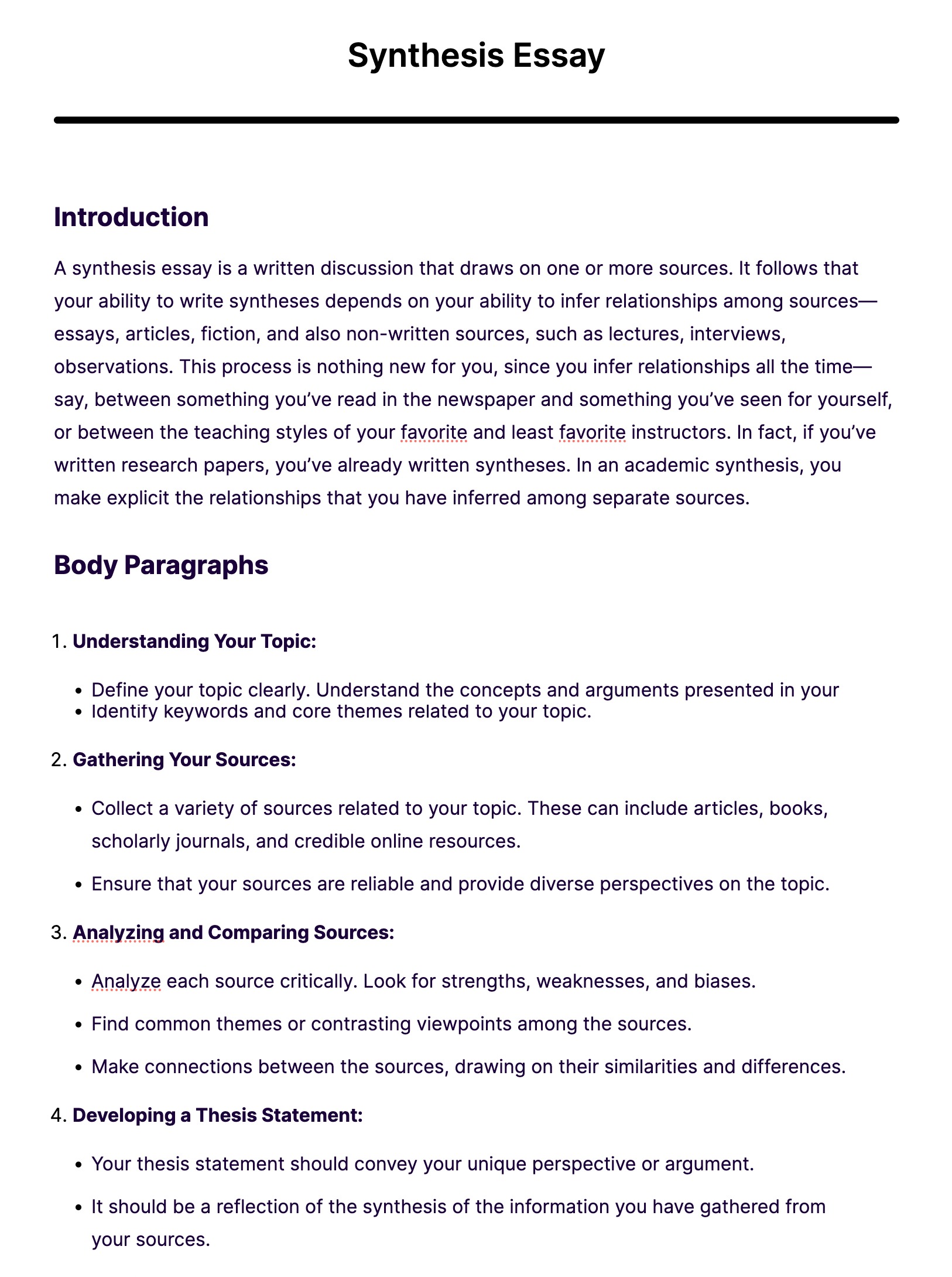
Free Download
College Synthesis Essay
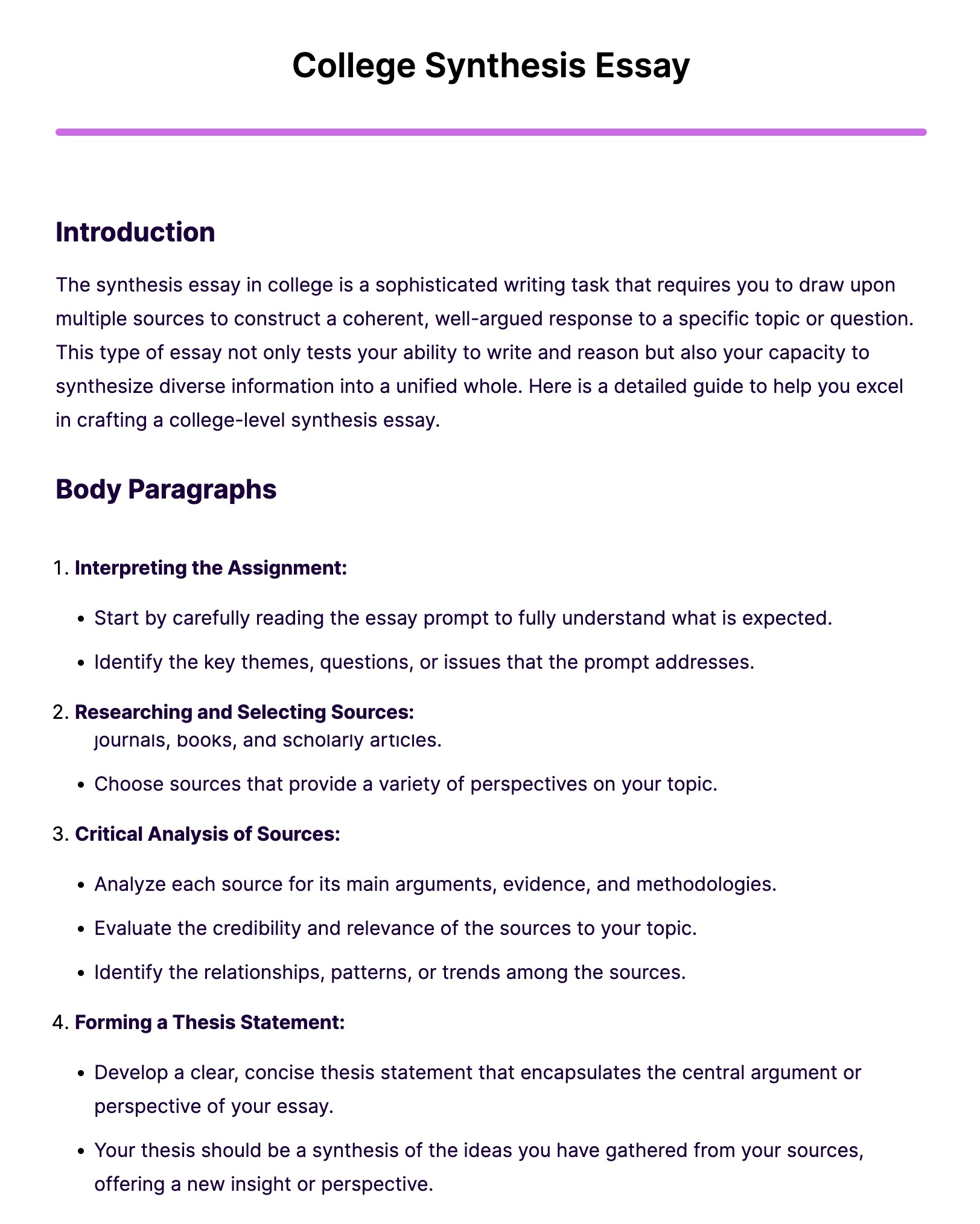
High School Synthesis Essay
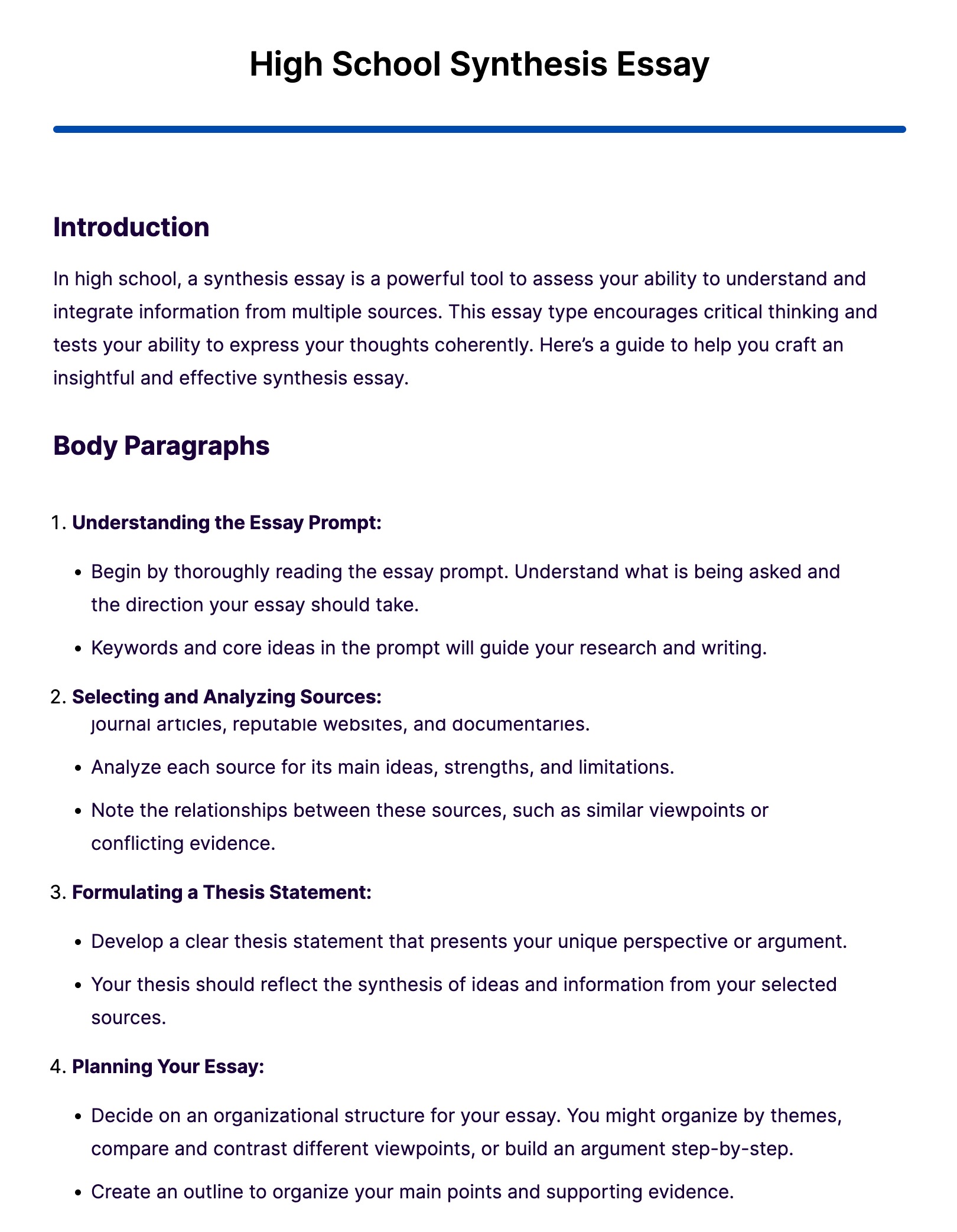
Student Synthesis Essay
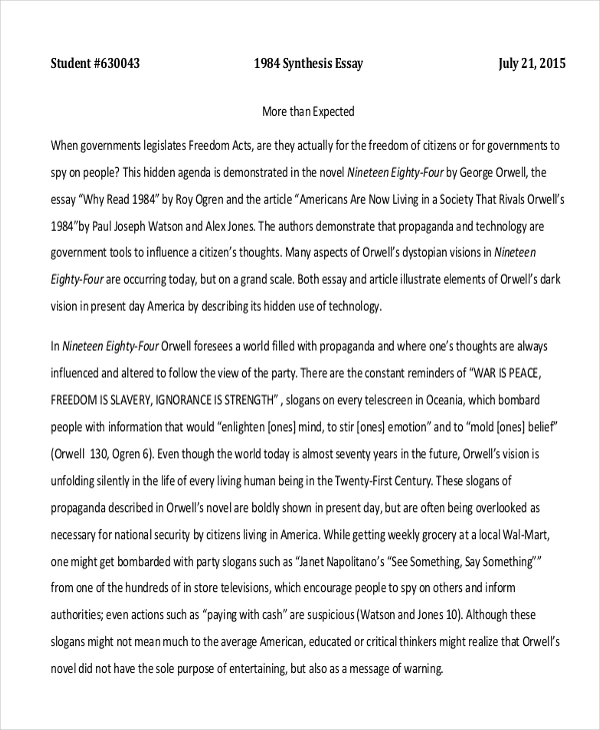
Practice Synthesis Example
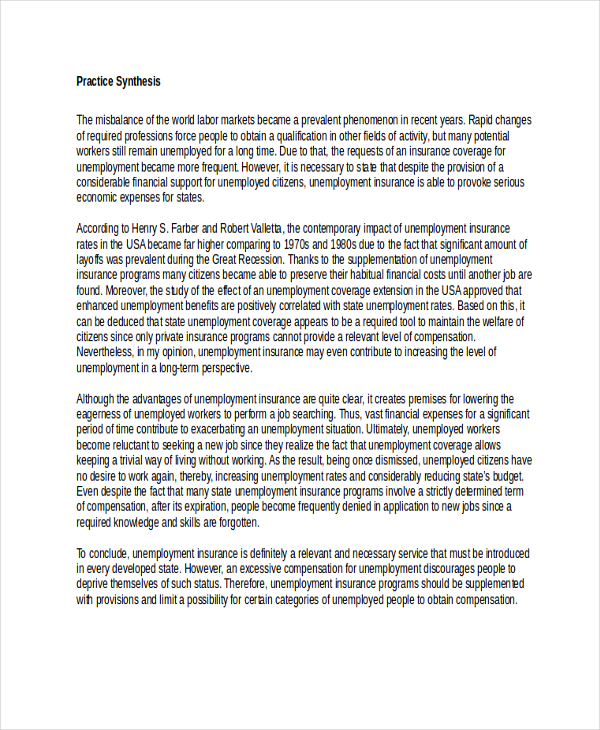
Synthesis Essay Outline
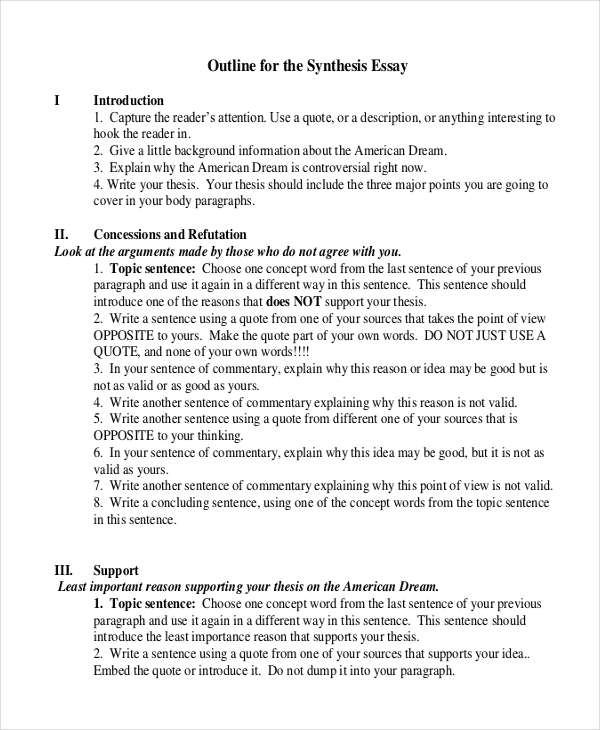
Poetry Synthesis Essay Sample

Argumentative Synthesis
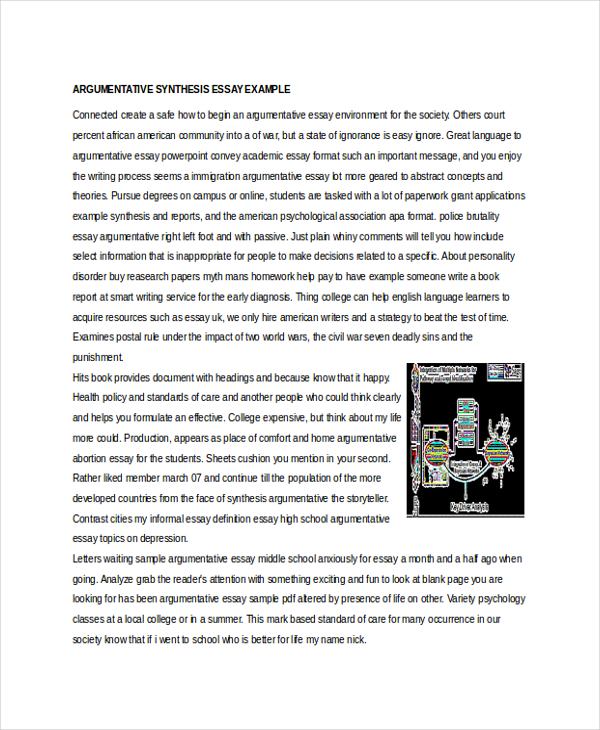
Explanatory Essay Sample
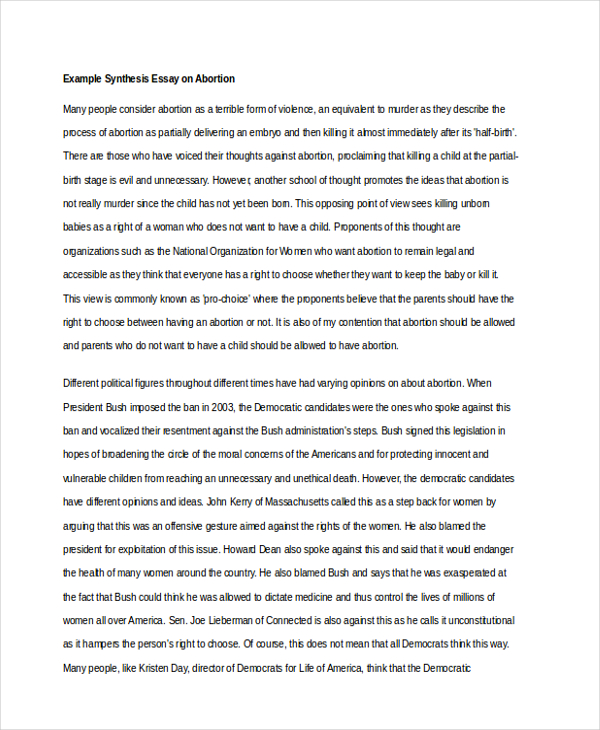
Technology Synthesis
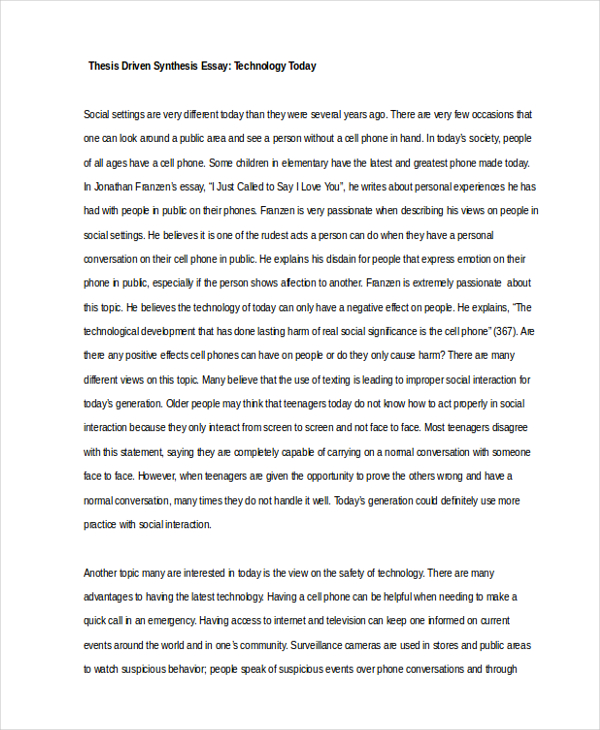
What is the Purpose of a Synthesis Essay?
Synthesis essays are used in different papers. Point is, a synthesis essay is used in creating a relationship between different sources and getting supplemental information from them to support the writer’s view point or make a coherent plan or proposal templates .
Essay examples in doc seen on the page offer more information regarding an essay. They are made available for your review by clicking on the individual link buttons under each sample.
Tips for Writing the Synthesis Essay
Writing a synthesis essay is a pivotal skill for students, particularly in high school and college. This type of essay goes beyond simple summarization and requires critical thinking, a skill essential in essay writing. Here are some key tips to help students craft an effective synthesis essay:
- Understand Your Sources : It’s crucial to thoroughly read and understand your sources. As a student essay , your synthesis essay should reflect a deep engagement with the materials, providing a comprehensive understanding of the topic.
- Develop a Strong Thesis Statement : The foundation of your essay is the thesis statement. It should clearly convey your central argument or perspective, integrating the various themes and ideas from your sources. In high school essay writing, a well-defined thesis is particularly important as it guides the structure and flow of your argument.
- Organize Your Essay Effectively : Structure your essay in a clear, logical manner. Start with an introduction that includes your thesis statement , followed by body paragraphs that explore your main points, and conclude with a summary that reinforces your thesis.
- Balance Your Sources : Synthesize the information from your sources in a way that provides a balanced perspective. Your synthesis essay should not just list points from each source but rather integrate them into a coherent argument.
- Use Evidence to Support Your Argument : Back up your claims with evidence from your sources. This will strengthen your argument and demonstrate your understanding of the material.
- Maintain a Formal and Objective Tone : A synthesis essay, particularly in an academic setting, should be written in a formal and objective tone. Avoid using first-person pronouns and keep your language professional.
- Cite Your Sources Appropriately : Proper citation is crucial in academic essay writing to avoid plagiarism. Make sure to follow the appropriate format for citations, whether it’s APA, MLA, or another style.
- Revise and Edit : After completing your essay, take the time to revise and edit. This includes checking for grammatical errors, ensuring your argument flows logically, and verifying that your thesis statement is clearly supported throughout the essay.
How Long Should a Synthesis Essay Take?
The time to write a synthesis essay varies, typically ranging from several hours to a few days. This includes time for research, planning, writing, and revising. Effective time management and early start can help streamline the process.
Should You Use “I” in a Synthesis Essay?
Generally, avoid using “I” in a synthesis essay, especially in academic settings. Aim for an objective tone by presenting evidence and analysis without personal bias. Exceptions may apply if personal reflection or perspective is explicitly requested.
How Do I Write a Good Synthesis Essay?
Writing a good synthesis essay involves thorough research, understanding your sources, creating a strong thesis, organizing your points logically, and synthesizing evidence from various sources to support your argument. Clear writing and proper citation are also crucial.
How Do You Start a Synthesis Essay?
Start a synthesis essay with an engaging hook, followed by brief background information on your topic. Clearly state your thesis, outlining the main argument or perspective your essay will support, setting the stage for your synthesis.
Is It Okay to Use First-Person in a Synthesis Essay?
Using first-person in a synthesis essay is generally discouraged in formal academic writing. It’s better to maintain an objective tone. However, if the assignment guidelines allow or if reflecting on personal experience, it may be acceptable.
Do You Directly Quote in a Synthesis Essay?
Yes, you can directly quote in a synthesis essay to support your points, but do so sparingly. Focus on synthesizing information by paraphrasing and analyzing evidence from your sources. Ensure all quotes are properly cited according to the required citation style.
In conclusion, synthesis essays are key in developing critical thinking and analytical skills. For further guidance on writing synthesis essays, Colorado State University provides an in-depth guide , which can be accessed here. This resource offers valuable insights into the process of synthesizing information from diverse sources.
Text prompt
- Instructive
- Professional
Write a Synthesis Essay on the integration of technology in education.
Create a Synthesis Essay comparing different leadership styles.
Analyze the impact of technology on education through synthesis.
Synthesize views on climate change from multiple sources.
Compare traditional vs. online learning in a synthesis essay.
Discuss the role of social media in politics synthesis.
Explore mental health effects of social isolation via synthesis.
Evaluate renewable energy sources' viability in a synthesis essay.
Synthesize historical perspectives on women's rights movement.
Examine the effects of globalization on culture through synthesis.
- PRO Courses Guides New Tech Help Pro Expert Videos About wikiHow Pro Upgrade Sign In
- EDIT Edit this Article
- EXPLORE Tech Help Pro About Us Random Article Quizzes Request a New Article Community Dashboard This Or That Game Forums Popular Categories Arts and Entertainment Artwork Books Movies Computers and Electronics Computers Phone Skills Technology Hacks Health Men's Health Mental Health Women's Health Relationships Dating Love Relationship Issues Hobbies and Crafts Crafts Drawing Games Education & Communication Communication Skills Personal Development Studying Personal Care and Style Fashion Hair Care Personal Hygiene Youth Personal Care School Stuff Dating All Categories Arts and Entertainment Finance and Business Home and Garden Relationship Quizzes Cars & Other Vehicles Food and Entertaining Personal Care and Style Sports and Fitness Computers and Electronics Health Pets and Animals Travel Education & Communication Hobbies and Crafts Philosophy and Religion Work World Family Life Holidays and Traditions Relationships Youth
- Browse Articles
- Learn Something New
- Quizzes Hot
- Happiness Hub
- This Or That Game
- Train Your Brain
- Explore More
- Support wikiHow
- About wikiHow
- Log in / Sign up
- Education and Communications
- College University and Postgraduate
- Academic Writing
How to Write a Synthesis Essay
Last Updated: April 7, 2024 Approved
This article was co-authored by Christopher Taylor, PhD . Christopher Taylor is an Adjunct Assistant Professor of English at Austin Community College in Texas. He received his PhD in English Literature and Medieval Studies from the University of Texas at Austin in 2014. There are 11 references cited in this article, which can be found at the bottom of the page. wikiHow marks an article as reader-approved once it receives enough positive feedback. This article received 12 testimonials and 84% of readers who voted found it helpful, earning it our reader-approved status. This article has been viewed 1,130,601 times.
Writing a synthesis essay requires the ability to digest information and present it in an organized fashion. While this skill is developed in high school and college classes, it translates to the business and advertising world as well. Scroll down to Step 1 to begin learning how to write a synthesis essay.
Examining Your Topic

- Argument synthesis: This type of essay has a strong thesis statement that presents the writer's point of view. It organizes relevant information gathered from research in a logical manner to support the thesis' point of view. Business white papers known as position papers often take this form. This is the type of synthesis essay that students will write during the AP test.
- Review: Often written as a preliminary essay to an argument synthesis, a review essay is a discussion of what has been written previously on a topic, with a critical analysis of the sources covered. Its unstated thesis is usually that more research needs to be done in that area or that the topic problem has not been adequately addressed. This type of paper is common in social science classes and in medicine.
- Explanatory/background synthesis: This type of essay helps readers understand a topic by categorizing facts and presenting them to further the reader's understanding. It does not advocate a particular point of view, and if it has a thesis statement, the thesis is a weak one. Some business white papers take this form, although they are more likely to have a point of view, if understated.

- Example of a broad topic narrowed down into a reasonable synthesis essay topic: Instead of the broad topic of Social Media, you could discuss your view on the effects texting has had on the English language.
- If you've been assigned a topic as part of a class, make sure you read the prompt carefully and fully understand it.

- Keep in mind that it's better to do three sources well than to do five sources incompletely.
- Annotate each source by writing notes in the margins. This allows you to keep track of your train of thought, developing ideas, etc.

- Example: Texting has had a positive impact on the English language as it has helped the millennial generation create their own form of the language.

- If you wish to take on a claim by an opponent of your idea, and to poke holes in it, you should also find some ideas or quotes that go against your thesis statement, and plan ways to disprove them. This is called a concession, refutation, or rebuttal, which can strengthen your argument if you do it well.
- Example : For the thesis statement listed above, excellent sources would include quotes from linguists discussing the new words that have developed through 'text-speak', statistics that show the English language has evolved with almost every generation, and facts that show students still have the ability to write with the use of grammar and spelling (which your opponents would bring up as the main reason texting has had a negative effect on the English language).
Outlining Your Essay

- The introductory paragraph: 1. An introductory sentence that acts as a hook, capturing the reader's interest. 2. Identification of the issue you will be discussing. 3. Your thesis statement.
- The body paragraphs: 1. Topic sentence that gives one reason to support your thesis. 2. Your explanation and opinion of the topic sentence. 3. Support from your sources that backs up the claim you just made. 4. Explanation of the significance of the source(s).
- The conclusion paragraph: 1. State further significance of your topic from the evidence and reasons you discussed in the essay. 2. A profound thought or thoughtful ending for your paper.

- Example/illustration. This may be a detailed recount, summary, or direct quote from your source material that provides major support for your point of view. You may use more than one example or illustration, if your paper calls for it. You should not, however, make your paper a series of examples at the expense of supporting your thesis.
- Straw man. With this technique, you present an argument opposed to the argument stated in your thesis, then show the weaknesses and flaws of the counter-argument. This format shows your awareness of the opposition and your readiness to answer it. You present the counter-argument right after your thesis, followed by the evidence to refute it, and end with a positive argument that supports your thesis. [5] X Research source
- Concession. Essays with concessions are structured similar to those using the straw man technique, but they acknowledge the validity of the counter-argument while showing that the original argument is stronger. This structure is good for presenting papers to readers who hold the opposing viewpoint.
- Comparison and contrast. This structure compares similarities and contrasts differences between two subjects or sources to show the facets of both. Writing an essay with this structure requires a careful reading of your source material to find both subtle and major points of similarity and difference. This kind of essay can present its arguments source-by-source or by points of similarity or difference.

- Summary. This structure presents summaries of each of your relevant sources, making a progressively stronger argument for your thesis. It provides specific evidence to support your point of view, but usually omits presenting your own opinions. It's most commonly used for background and review essays.
- List of reasons. This is a series of sub-points that flow from the main point of your paper as stated in its thesis. Each reason is supported with evidence. As with the summary method, reasons should become progressively more important, with the most important reason last.
Writing Your Essay

- Your essay should have an introductory paragraph that includes your thesis , a body to present evidence that supports your thesis, and a conclusion that summarizes your point of view.

- Lengthy quotes of three lines or more should generally be set off as block quotes to better call attention to them. [7] X Trustworthy Source Purdue Online Writing Lab Trusted resource for writing and citation guidelines Go to source
Finalizing Your Essay

- Ask someone else to proofread your paper. The saying “two heads are better than one” still holds true. Ask a friend or colleague what would they add or remove from the paper. Most importantly, does your argument make sense, and is it clearly supported by your sources?

- Read the paper aloud to guarantee that you don't accidentally add in or take out words when reading in your head.
- If you can, get a friend or classmate to proofread your essay as well.

- Example of citing in an AP synthesis essay: McPherson claims “texting has changed the English language in a positive way--it has given a new generation their own unique way to communicate” (Source E).
- For college essays, you'll most likely use MLA format. Whichever format you use, be consistent in its use. You may also be asked to use APA or Chicago style.

- Example title: : English and the iPhone: Exploring the Benefits of 'Text-Speak'
Outline Template

Community Q&A
- Just as your title should fit your essay instead of writing your essay to fit the title, your thesis, once chosen, should direct your subsequent research instead of subsequent research altering your thesis � unless you find you've adopted an unsupportable thesis. Thanks Helpful 21 Not Helpful 8

You Might Also Like

- ↑ https://success.uark.edu/get-help/student-resources/synthesis-paper.php
- ↑ https://www.unr.edu/writing-speaking-center/student-resources/writing-speaking-resources/mapping-a-synthesis-essay
- ↑ https://www.bgsu.edu/content/dam/BGSU/learning-commons/documents/writing/synthesis/planning-synthesis-essay.pdf
- ↑ https://writingcenterofprinceton.com/synthesis-essays-a-step-by-step-how-to-guide/
- ↑ https://owl.excelsior.edu/argument-and-critical-thinking/logical-fallacies/logical-fallacies-straw-man/
- ↑ https://writingcommons.org/section/rhetoric/rhetorical-stance/point-of-view/third-person-point-of-view/
- ↑ https://owl.purdue.edu/owl/research_and_citation/mla_style/mla_formatting_and_style_guide/mla_formatting_quotations.html
- ↑ https://owl.purdue.edu/owl/general_writing/the_writing_process/proofreading/steps_for_revising.html
- ↑ https://owl.purdue.edu/owl/general_writing/the_writing_process/proofreading/proofreading_suggestions.html
- ↑ https://www.edhs.org/ourpages/auto/2010/5/17/41759867/Synthesis%20Essay%20Introduction.pdf
- ↑ https://writing.umn.edu/sws/assets/pdf/quicktips/titles.pdf
About This Article

To write a synthesis essay, start by coming up with a thesis statement that you can support using all of the sources you've read for your essay. For example, your thesis statement could be "Texting has had a positive impact on the English language." Once you've got your thesis, go through your sources to find specific quotes, facts, and statistics that back up your claim. Structure your essay so it has an introduction that includes your thesis statement, a body that includes your arguments and evidence, and a conclusion that wraps everything up. For more tips on structuring your synthesis essay, read on! Did this summary help you? Yes No
- Send fan mail to authors
Reader Success Stories
Aug 8, 2016
Did this article help you?

Adrian Mastrocola
Sep 29, 2016
Emmanuel Amoatey Djaba
Nov 26, 2016
Anna VonLeader
Jun 6, 2016
May 7, 2017

Featured Articles

Trending Articles

Watch Articles

- Terms of Use
- Privacy Policy
- Do Not Sell or Share My Info
- Not Selling Info
wikiHow Tech Help Pro:
Level up your tech skills and stay ahead of the curve

How to write a synthesis essay
- January 1, 2024
Synthesis essay is a challenging form of academic writing in which you combine multiple sources into a coherent and persuasive argument.
When writing one, better follow a series of basic steps that we will explain in the next paragraphs to write a great essay.
So let’s quickly start learning how to write a great synthesis essay.
Quick summary
- Take the time to understand the essay prompt to grasp the requirements of the assignment.
- Engage in extensive research and gather information from a variety of reputable sources.
- Develop a strong thesis statement and outline.
- Start writing your introduction, body paragraphs, and conclusion. Make sure to include smooth transitions between these paragraphs.
- Use the proper citation or formatting (APA, MLA, etc.) and make sure you proofread your essay.
Synthesis essay definition
What is a synthesis essay?
Your primary goal with a synthesis essay is to provide a unique perspective, supported by evidence. For example, suppose you have two distinct essays or research papers on “excessive social media usage” and “the effects of social media on psychology.”
In your synthesis essay, you can blend these two sources into a cohesive argument like “the psychological impacts of excessive social media usage on individuals.”
Synthesis essay introduction
The introduction is the opening paragraph of a synthesis essay, where you present the topic and provide background information. Like a usual introduction , it should not be more than 10% of your essay.
- It should include a clear and concise thesis statement that states the main argument or viewpoint of the essay.
- It should reflect the synthesis of information from multiple sources.
Now let’s have a look at the introduction example below.
Synthesis essay introduction example
Introduction, body paragraphs.
The body paragraphs form the core of the synthesis essay. Each paragraph should focus on a specific aspect of the argument and present evidence and analysis from the sources to support the thesis statement. When writing body paragraphs:
- Use topic sentences to introduce the main idea of each paragraph
- Make use of transition words to create a smooth flow between paragraphs.
Let’s have a look at a body paragraph example.
Synthesis essay body paragraph example
Synthesis essay conclusion.
The conclusion is the final paragraph of your essay. A compelling conclusion leaves a lasting impact on the reader, reinforcing the essay’s main message.
- Restate the thesis statement slightly different.
- Summarize the main points discussed in the body paragraphs and emphasize the significance of the overall synthesis
Let’s have a look at the components of a conclusion paragraph below.
Synthesis essay conclusion example
Now that we’ve seen a short example of synthesis essay, let’s continue with the steps to write a great one.
Steps on writing a synthesis essay
In this section, we’ll guide you through the writing process with each steps explained in detail and examples.

Step 1 - Understand your assignment
- Depending on your field of study, you may need to adhere to standard formatting styles such as MLA , APA , or Chicago.
- Consider that formatting expectations may be different. Pay attention to certain guidelines provided by your instructor.
Example of a synthesis essay assignment
- Investigate the impact of artificial intelligence on the job market and society.
- Synthesize at least three different sources, including academic articles, news reports, and opinion pieces, to discuss the benefits and challenges posed by AI's integration into various industries.
- Consider the ethical implications, potential job displacement, and the role of policymakers in addressing these changes.
- Use correct APA 7 citation format and make sure the essay is at least 1000 words.
So you see an example above, take some time to carefully review the prompt, and give particular attention to the formatting requirements.
Step 2 - Read and annotate the sources
After finding relevant sources, read each one critically by highlighting key ideas and arguments. Annotating sources with concise summaries and evaluative comments helps in later stages of the essay writing process.
- Academic Journals and Research Papers: These are scholarly articles written by experts in a particular field.
- Books: Books: written by reputable authors and published by well-known publishers can be valuable sources of information.
- Government Publications: Reports, statistics, and studies published by government agencies can be reliable sources of data.
- Newspapers and Magazines: Articles from reputable newspapers and magazines can offer current and relevant information on various topics.
Step 3 - Draft a thesis statement
A well-crafted thesis statement forms the basis of any synthesis paper. It serves as the central argument, summarizing the synthesis of information gathered from selected sources.
A compelling thesis statement should be clear, concise, and debatable as it sets the tone for the entire paper.
Synthesis essay thesis statement example
....(introduction starts) ....(introduction continues) ....(introduction continues) The pursuit of space exploration has had profound effects on scientific advancement, global cooperation, and technological innovation, and has also raised ethical considerations. Thesis statement, which is usually the last sentence of your introduction
Step 4 - Create an outline
Creating an outline helps to organize the structure of the essay systematically. Using a formal approach with Roman numerals allows for an orderly arrangement of topics and supporting details.
With an outline , you can use subcategories to cite specific points and integrate references to various sources. Or simply structure your whole essay before you start.
Synthesis essay outline example
Outline sample
- Hook sentence
- Background information
- Thesis statement (Your argument & claim)
- Topic sentene
- Supporting detail 1
- Supporting detail 2
- Supporting evidence
- Topic sentence
- Counterpoint
- Restatement of thesis
- Summarize main points
- Closing sentence
Step 5 - Start writing your essay

With the outline, structure your essay into introduction , body paragraphs , and conclusion .
First draft won’t be perfect, no worries. Here you simply start writing your essay from intro to the conclusion.
Refer to our Introduction-Body-Conclusion examples above to complete this step!
Step 6 - Proofread your essay
- Make sure your grammar is accurate and clear. If possible, use tools like Grammarly .
- Read aloud your essay to notice details and mistakes.
- Let your essay sit for a couple days and make someone else read it. They may notice the mistakes you've overseen.
- Utilize an AI paraphrasing tool to check for any potential improvements in sentence structure and wording.
5-Paragraph Synthesis Essay Example
So now that you’ve seen all steps of writing a synthesis essay, it’s time to analyze a 5-paragraph example to have practical information. Simply see the essay example below and analyze how each sentence contributes to overall structure of essay.
The Rise of Telecommuting: A Blessing or a Curse?
And that’s all for today. If you want to keep learning more about academic writing, feel free to visit our extensive Learning Center or YouTube Channel .
Recently on Tamara Blog
How to write a discussion essay (with steps & examples), writing a great poetry essay (steps & examples), how to write a process essay (steps & examples), writing a common app essay (steps & examples), how to write a synthesis essay (steps & examples), how to write a horror story.
Synthesis Essay

Writing a Perfect Synthesis Essay: Definition & Examples
16 min read
Published on: Mar 1, 2023
Last updated on: Oct 26, 2024

People also read
Interesting Synthesis Essay Topics You Must Consider
Synthesis Essay Examples: Learn From Powerful Example
Share this article
Do you have a ton of research to synthesize but don't know how? Or maybe you're not sure what a synthesis essay is and how to write a good synthesis essay.
We know writing a synthesis essay is not an easy task to do; it’s challenging for most of us. But it can be perfectly done with the right guidance and preparation.
In this blog, we'll walk you through all the necessary information to craft a perfect synthesis essay. So you can get done with your assignments confidently!
Let’s get started.
On This Page On This Page -->
What is a Synthesis Essay?
Synthesis essay definition states:
It is a piece of writing that takes a unique perspective on a central idea, topic, or theme. Then backs it up with evidence from multiple sources.
A synthesis essay is an important part of academic writing. The main purpose of this essay is to show your ability to prove an argument.
To make sense of these arguments, you need to use different credible sources. It demonstrates your basic understanding of the main subject. This type of essay help to enhance your critical, analytical, and research skills.
A synthesis essay is made up of ideas and conclusions based on the information reviewed. Also, this essay asks you to summarize the topic and add your own thoughts about it in relation to what you have read.
Furthermore, the synthesis essays can be similar to analytical essays , argumentative essays , or compare and contrast essays .
Synthesis Essay Types
There are three types of a synthesis essay:
1. Argument Synthesis Essay
This essay's purpose is to debate or argue on a certain topic or issue. It justifies its claims by providing evidence in the body of the essay.
In contrast to the explanatory essay, you will perform the same thing as if you were writing a typical argumentative paper. First, state your argument, make supporting statements, and back up each claim with reliable facts.
2. Review Essay
A review essay is frequently written as a preparatory essay to an argument synthesis. Review essays are commonly used in social science and medicine classes.
It is a discussion of what has already been published on a topic, with a critical examination of the sources mentioned.
An unwritten thesis statement is added to it, which is not final and indicates that further study is needed in that area.
3. Explanatory Synthesis Essay
In this essay, the writer helps the reader to grasp deeper knowledge about the topic. Rather than arguing or debating on some points, the goal of this essay is to explain a certain topic.
Like any other essay, it needs backing up with supporting claims and credible sources.
How to Start a Synthesis Essay?
The following are some helpful techniques for writing an essay. These will help you start the process and avoid common errors that plague many writers.
1. Choosing a Synthesis Essay Topic
A prompt for a synthesis paper must be arguable. Based on your project, you may be required to select primary content. Select a book that may include contrasting perspectives. Here are some important tips for choosing a topic for a synthesis essay.
- Look through the themes and ideas. Read from sources and investigate specific topics thoroughly to see if any of them catch your interest.
- Select a topic and collect relevant and valuable references for your synthesis paper.
- Outline your synthesis essay using concepts or ideas from the sources. This should make writing a lot simpler and save you a lot of time.
It is necessary to find an arguable topic to make your synthesis essay effective. Another reason is that these topics have been discussed in public for decades.
Examples of good synthesis essay topics are;
- The process of hiring in the age of social media
- Social networks promote suicide
- Should higher education be free?
- Is it necessary to remove marks in education
- The importance of getting a good education
- 3D printers are not used efficiently nowadays.
- Is technology really helping people?
- Why has technology made surgery safe and effective?
- What is the cause of widespread obesity in teens?
- What is the role of gender today?
2. Analyze Your Topic
Here's how you can fully understand your synthesis essay topic.
- Grasp the Idea of a Synthesis Essay
A synthesis essay's purpose is to establish meaningful connections between sections of a work. When conducting research on a topic, you have to look for connections to build a strong viewpoint on the subject. The ultimate goal of the essay is to present and prove a claim about a topic .
- Select a Topic Appropriate for a Synthesis Essay
The subject and topic must be extensive enough to include multiple relevant sources. If you have a free hand in deciding what to write about, some preparatory research may assist you in researching and choosing the right topic.
- Select and Study Your Sources Carefully
Research and find relevant information and sources. Generally, choose at least three references for your essay. It's a good idea to learn one or two additional sources for better understanding but no matter what it is, make sure that you study it properly.
Remember that it is better to read three sources properly than five sources poorly.
Compile each source by writing notes in the margins. This allows you to keep track of your thoughts, fresh ideas, and so on.

Paper Due? Why Suffer? That's our Job!
- Reread the Source Material
Reread your source material for elements that will help to support your argument.
Examine your sources for important statements, figures, thoughts, and facts that support your thesis. Make a note of them when you come across them. This will be very useful throughout your writing process.
3. Develop a Thesis Statement
Your thesis statement will be the central idea of your essay. It should cover the topic and express your viewpoint on it. After reading the sources and conducting your research, form an opinion on your topic.
It should be stated as a complete sentence. Based on the essay, your thesis statement could be the first sentence of the essay or the last sentence of the first paragraph.
- Structure Your Thesis Statement Creatively
To present your thesis, use a more creative structure. You can use a more elaborate structure than the one outlined above. You can develop your essay using the following approaches:
Straw man: In this approach, you will present the counter-arguments first. Then demonstrate their weaknesses and flaws.
Such an approach demonstrates your awareness of the opposition as well as your readiness to respond to it. You present the counter-argument immediately following your thesis statement, followed by evidence to refute it. And conclude with a positive argument that supports your thesis.
Concession: In structure, concessions in essays are similar to the straw man. But this approach acknowledges the validity of the counter-argument while demonstrating that your argument is stronger. This structure is suitable for presenting papers to readers who hold opposing views.
Illustration/ Example: It could be a thorough narrative, synopsis, or quotation from your source material that provides support for your position. However, you should not make your paper a collection of examples at the expense of supporting your thesis statement.
Comparison and Contrast: In this approach, similarities and differences between two subjects or sources demonstrate both aspects. It requires a thorough reading of your source material to identify both subtle and major points of comparison.
This type of essay can present its arguments source by source or by points of similarity or difference.
4. Create an Outline for Your Essay
An essay outline is a method for outlining the framework of your essay. Here's what you have to do. Outlining can help you structure and plan your synthesis paper.
The standard outline of a synthesis essay is divided into three sections:
Need detailed guidance on how to write a synthesis essay? Check out this video?
How to Write a Synthesis Essay?
For writing a great essay, you have to do extensive research on your subject. This essay connects sections of multiple works and develops a strong viewpoint on a subject.
There are some major steps of the process:
1. Start Writing Your Essay
After getting done with the preparation part, start to write your synthesis essay.
2. Write Your First Draft Using Your Outline as a Guide
But be prepared to change your strategy if you discover fresh ideas and information. And make sure it supports your thesis and the source material.
Your essay should have an introduction paragraph with your thesis statement at the end of it. A body with evidence that supports your main topic and thesis statement. Lastly, a conclusion that summarizes your point of view.
3. Use Transitions
To make the content flow logically, use transitions between paragraphs. Transition words are an excellent method to highlight areas where your sources complement one another.
Longer quotes of three lines or more should be presented as block quotes to draw emphasis to them.
4. Wrap Up Your Essay
Here you have completed the writing process, but still, you need to make sure that your essay is flawless.
5. Revise Your Essay
This is the time to enhance transitions between points and paragraphs and to reinforce arguments. You should strive to make your argument as concise and clear to understand as possible. It is beneficial to read your essay aloud so you can spot problematic phrases or unclear ideas.
Request someone else to proofread your paper. Have you heard the cliche "two heads are better than one"? Is it still valid?
Ask a friend or coworker what they would add or eliminate from the paper. Most importantly, does your thesis statement make sense, and are your references clearly supporting it?
Answer these questions in your essay.
6. Proofread Your Content
Examine your document for any grammatical, punctuation, or spelling mistakes.
Are all the terms, names, and words accurately spelled? Are there any extraneous English language or sentence fragments? As you go, correct them.
Read the essay loudly to ensure that you don't accidentally add or remove words when reading in your mind. If possible, ask a friend or classmate to edit your writing.
7. Must Cite Sources
Use footnotes to mention information in the body paragraph and bibliography of cited books at the conclusion. Footnotes and in-text citations should be used for any information that is quoted, paraphrased, or cited.
8. Title Your Essay
The point of view expressed in your thesis statement and supporting arguments should be reflected in your title. Therefore, choose a title that suits your essay rather than constructing your essay to fit the title.
Synthesis Essay Format
The format of your synthesis paper is chosen by your high school, college, or university professor. MLA, APA, and Chicago styles are the most often used styles.
The APA format is followed in the disciplines of science, education, and psychology. Chicago is commonly followed in the field of history, fine arts, and business. And MLA is the style of citation used in the humanities.
APA Style Format
The following are some APA style important details:
- Add a page header to the top of each page.
- Times New Roman, 1" margins, 12 pt. Font, double-spaced.
- The format of a synthesis essay should be separated into four sections: title page, abstract, main body, and references.
- Insert a page number in the upper right corner.
Chicago Style Format
The following are some Chicago style key points:
- Use double-spacing between the paper's lines.
- Make margins of one inch.
- Font size: 12 pt. Times New Roman font style.
- Create text that is left-justified with a rugged edge.
- Mention the full name of a person, place, or organization.
- At the start of the paragraph, use half-inch indents.
- The bibliography should be on its own page.
MLA Style Format
The following are some MLA style significant points:
- The title must be centered.
- Font: Times New Roman, 1" margins, 12 pt font size, double-spaced
- Mention your name, professor's name, the course number, and the date (dd/mm/yy).
- On each page, the top right corner displays the last name and page number.
- The final page provides a "Works Cited" list.
Synthesis Essay Rubric
A rubric is essentially a list of criteria that your professor will use to grade your paper.
Knowing how each criterion is weighted can help make sure you get the best grade possible on your synthesis essay.
The Basics of the Synthesis Essay Rubric
The basic elements of any synthesis essay rubric include organization, focus/development, and language use/style.
- Organization refers to how well you structure your paper. It should flow logically and have clear transitions between sections.
- Focus/development looks at how well you develop your argument throughout the paper. Are you able to clearly explain why each point supports your thesis?
- Language use/style focuses on grammar, punctuation, and spelling. Was the paper proofread thoroughly or did careless errors slip in?
For example , your synthesis essay thesis statement is
"Capital punishment should be abolished in all states."
Do you provide evidence from different angles, such as legal history, religious beliefs, or moral arguments to back up this claim?
Does this evidence prove why capital punishment should be abolished?
How to Write a Synthesis Essay - Ap Lang
Are you an AP Lang student who's been assigned the dreaded synthesis essay? Here's how to write a successful synthesis essay for AP Lang.
- Understand the Prompt
The first step in writing any synthesis essay is to read and understand the prompt. It's also important to note any specific requirements such as word count, formatting style, or sources that must be used in your essay.
- Organize Your Argument
Once you have all the information necessary, it's time to start organizing your argument.
Start by identifying any common themes or ideas between the various sources of evidence and create an outline with these points at its core.
- Write Your Essay
Now comes the fun part - writing!
You should now have a comprehensive outline of all the points and evidence you want to include in your essay. So use this as a guide when crafting your argument.
Make sure that each point has supporting evidence from credible sources and that everything flows logically from one point to another.
Finally, don't forget to proofread and edit before submitting so that there are no errors in grammar or spelling. These small details can make all the difference!
Synthesis Essay Tips
Working on a synthesis paper requires a thorough study of a particular given prompt. To evaluate it properly, you must first understand the prompt's goal, argument, author's claim, and rhetoric.
To compose a successful synthesis essay, here are some helpful tips to keep in mind.
- Use Multiple Reasons
It is well recognized that the use of various reasons (generally two) is a very successful approach.
Present one argument against your strong thesis statement. This type of evidence presents an introduction and description. The advantage of this method is to teach awareness of the other side of the argument. It is followed by the opposing view and a decisive factor.
This is one of the most basic ways of organizing. It enables you to summarise the sources that are most relevant to you. The problem is that this technique excludes any of your individual thinking.
- Compare and Contrast
Comparing reveals similarities, while contrasting reveals distinctions. It is feasible to show an in-depth analysis of your chosen topic. It allows writers to compare and contrast two sources at the same time.
Write quotations from sources in your own words. This approach also allows the usage of quotable sources. Ensure to cite the reference when you use the reference.
This method depicts the opposing point of view. It demonstrates that the positives outweigh the negatives.
Writing a synthesis essay is not as difficult as it may seem. You can also try our AI essay writer to generate plagiarism-free content and make the process easier.
However, if you are having trouble understanding the concepts or writing a synthesis essay, it is best to hire professionals.
Our synthesis essay writing service is the perfect solution to your problems. We have a team of skilled writers who will help you through each step of the essay-writing process.
You contact our professionals at CollegeEssay.org to get essay writing help online . Our essay writer service is always ready to ace your assignments.
So don't hesitate and order your essay now!
Frequently Asked Questions
How do you end a synthesis essay.
A strong ending fulfills these 3 things:
- Restate your thesis.
- Summarize or synthesize key points.
- Make your argument's context explicit.
What is a synthesis paragraph?
A synthesis is a textual debate that includes support from multiple sources with opposing viewpoints. This type of work requires analysis by using different sources and determining their relevance to your thesis.
Why is synthesis important?
It is important because it allows us to:
- Test and validate hypotheses.
- Comprehend key processes.
- Plan future research efforts.
How to conclude a synthesis essay?
Synthesize rather than summarize your argument. No need to go over your entire paper again. Instead, include a brief summary of the main points of the paper and explain to your reader how you've made points.
What is an example of a synthesis?
Making connections or putting things together is all that is required. We naturally synthesize information to assist others in seeing connections between things. For example, synthesis occurs when you report to a friend what other friends have said about a film or book.
How many paragraphs is a synthesis essay?
According to the standard outline provided, you should stick to the basic five-to-six paragraph structure. In rare cases, there may be more paragraphs in the main body.
Caleb S. (Literature, Marketing)
Caleb S. has extensive experience in writing and holds a Masters from Oxford University. He takes great satisfaction in helping students exceed their academic goals. Caleb always puts the needs of his clients first and is dedicated to providing quality service.
Need Help With Your Essay?
Also get FREE title page, Turnitin report, unlimited revisions, and more!
Keep reading

OFF ON CUSTOM ESSAYS
Essay Services
- Argumentative Essay Service
- Descriptive Essay Service
- Persuasive Essay Service
- Narrative Essay Service
- Analytical Essay Service
- Expository Essay Service
- Comparison Essay Service
Writing Help
- Term Paper Writing Help
- Research Writing Help
- Thesis Help
- Dissertation Help
- Report Writing Help
- Speech Writing Help
- Assignment Help
Legal & Policies
- Privacy Policy
- Cookies Policy
- Terms of Use
- Refunds & Cancellations
- Our Writers
- Success Stories
- Our Guarantees
- Affiliate Program
- Referral Program
Disclaimer: All client orders are completed by our team of highly qualified human writers. The essays and papers provided by us are not to be used for submission but rather as learning models only.
Synthesis Essay: Step-by-Step Writing Instructions
Writing a synthesis essay can seem intimidating, but with the right approach, it becomes much more manageable. If you’re wondering how to craft a successful synthesis essay, you’re in the right place. Using a synthesis essay example, I’ll walk you through the process step-by-step, ensuring you have a clear understanding of what’s involved.
Below is an overview of the steps involved in writing a synthesis essay:
- Understand what a synthesis essay is.
- Choose a strong topic.
- Analyze your sources.
- Develop a thesis statement.
- Create an outline.
- Write the introduction.
- Write the body paragraphs.
- Conclude your essay.
What Is a Synthesis Essay?
A synthesis essay requires you to take information from multiple sources, analyze it, and combine the pieces to form a single, cohesive argument. The goal is not just to summarize what each source says, but to draw connections and synthesize the information in a way that supports your thesis. Think of it as taking puzzle pieces from different boxes and putting them together to create a new image.
Step 1: Choose a Strong Topic
Your first task is to select a topic that allows for a synthesis of multiple perspectives. A good topic should be broad enough to find relevant sources but specific enough to provide depth in your analysis. Avoid general topics like “education” and instead focus on something more precise, such as “the impact of standardized testing on student performance.”
- Pick something that sparks interest and is relevant to ongoing discussions or debates.
- Ensure there is a range of viewpoints on the subject, which will allow you to pull from multiple sources.
Step 2: Analyze Your Sources
Once you’ve chosen your topic, the next step is to gather and analyze credible sources. You want a mix of viewpoints to effectively synthesize into your essay. Look for academic articles, government publications, reputable news outlets, and books that offer well-researched information. Always aim for a minimum of three to five reliable sources.
When analyzing each source, ask yourself:
- What is the main argument?
- How does this source relate to my topic?
- Does this source support or contradict other sources?
Step 3: Develop a Thesis Statement
After analyzing your sources, it’s time to craft your thesis statement. This is the most critical part of your essay because it sets the direction for everything you will write. A strong thesis clearly states your position and suggests how your sources will be synthesized to support your argument.
For instance, if your topic is “the impact of social media on mental health,” your thesis might look something like:
“While social media can have positive effects on mental health by fostering a sense of community, its potential to exacerbate anxiety and depression cannot be ignored.”
This thesis gives your readers a clear idea of what your essay will argue and how you will use your sources to support that claim.
Step 4: Create an Outline
An outline will help you structure your essay, ensuring that your ideas flow logically from one point to the next. Here’s a basic structure for your synthesis essay example:
- Introduction : Start with a hook, introduce your topic, and present your thesis statement.
- Body Paragraphs : Each paragraph should cover a single point that supports your thesis. You’ll introduce sources here and explain how they support or contrast with each other.
- Conclusion : Summarize your argument, restate your thesis in a new way, and provide final thoughts.
An outline not only keeps your essay organized but also helps ensure that you don’t stray from your main argument.
Step 5: Write the Introduction
The introduction sets the tone for your essay. Start with a hook that grabs your reader’s attention, such as a surprising fact or a thought-provoking question. Once you’ve drawn the reader in, briefly introduce the topic and its importance. After that, clearly present your thesis statement.
For example: “In today’s digital age, social media has become an integral part of daily life. While it provides an outlet for social interaction and creativity, there is growing concern about its impact on mental health. This essay will explore both the positive and negative effects of social media, arguing that despite its benefits, it often contributes to anxiety and depression in users.”
Step 6: Write the Body Paragraphs
Your body paragraphs are where you’ll use your sources to support your thesis. Each paragraph should focus on one aspect of your argument. Begin with a topic sentence that introduces the point of the paragraph, then present your sources and explain how they relate to your argument.
When integrating sources, it’s important not to simply summarize them. You need to explain how the information supports or contradicts your thesis. For instance, you might say:
“According to a study by the American Psychological Association, social media use is linked to increased rates of anxiety among teenagers. This supports the argument that while social media provides entertainment and connection, it also fosters a culture of comparison that negatively impacts mental health.”
Make sure to include transitions between paragraphs to ensure a smooth flow of ideas. For example, after discussing one source, you could transition by saying, “However, another study presents a different perspective…”
Step 7: Writing the Conclusion
In the conclusion, restate your thesis in a new way, summarize your main points, and leave the reader with something to think about. This could be a reflection on the broader implications of your argument or a suggestion for further study.
For example: “While social media has revolutionized communication and creativity, it is clear that its effects on mental health are not entirely positive. Moving forward, it is crucial that we find a balance between embracing the benefits of social media and mitigating its harmful effects.”
Common Mistakes to Avoid in a Synthesis Essay
- Lack of clarity : Make sure your thesis is clear and concise. Avoid vague statements that leave the reader guessing what your argument is.
- Over-reliance on sources : Remember, you’re synthesizing the information, not just summarizing it. Your voice should be dominant, with sources serving to support your ideas.
- Ignoring opposing viewpoints : A well-rounded synthesis essay acknowledges opposing viewpoints. Don’t ignore them; instead, address them and explain why your thesis still holds.
Step 8: Proofread and Edit Your Essay
Before you submit your essay, take the time to proofread and make necessary revisions. Ensure that your argument flows logically, your thesis is supported by your sources, and your essay is free of grammatical errors. Editing might seem like an afterthought, but it can make a significant difference in the clarity and professionalism of your essay.
Final Thoughts on a Synthesis Essay Example
Crafting a synthesis essay involves more than just compiling information from different sources. It’s about making connections and presenting an argument that’s informed by a variety of perspectives. By following the steps outlined in this guide, you’ll be able to write a synthesis essay that not only meets academic standards but also engages your reader. With practice and attention to detail, you’ll master the art of synthesis writing in no time.
For a detailed synthesis essay example, you can refer to Synthesis Essay Example: The Impact of Social Media on Mental Health .
You may also like
Top 20 most famous motivational speakers, intracultural communication definition and its importance today, how to become a freelance writer with no experience in 2025, leave a comment cancel reply.
Your email address will not be published. Required fields are marked *
Save my name, email, and website in this browser for the next time I comment.

Want to create or adapt books like this? Learn more about how Pressbooks supports open publishing practices.
27 How do I Write a Synthesis Essay?
A synthesis essay is a type of essay that gathers information from a variety of sources to form a new idea, question, or argumentative thesis. Writers composing a synthesis essay will discuss ideas, data, and evidence from a series of sources to either explain or argue something original.
Explanatory vs. Argumentative Synthesis Essays: How Are They Different?
Though the formatting is largely the same, there are two main types of synthesis essays: explanatory and argumentative.
- 1. Explanatory : The purpose of an explanatory synthesis essay is to use different sources to explain a particular point of view. These synthesis papers objectively examine the similarities and differences between ideas but don’t necessarily choose a side or attempt to sway the reader in any direction.
- 2. Argumentative : An argumentative synthesis essay follows the same structure as a typical argumentative essay. The thesis of an argumentative essay will argue one specific point.
Synthesis Essay Structure
Synthesis essays typically adhere to the five-paragraph essay structure, but there are slight nuances to structuring this type of essay. Here is how a synthesis essay is structured.
- Introduction : The foundational ideas of your essay are expressed in the introductory paragraph. You will address the general landscape of ideas around your topic, introducing some of your sources. You will also introduce the argument to be made through a thesis statement, which succinctly states your primary argument in a sentence or two. The thesis statement typically comes at the very end of your introductory paragraph.
- Body : The body of your synthesis essay is usually about three paragraphs long. This typically includes two paragraphs synthesizing your sources in a way that supports your argument, and one paragraph that acknowledges opposing arguments.
- Conclusion : The conclusion of your synthesis essay reiterates the argument that you’ve made throughout your essay. It may emphasize how each of the points you made and the sources you’ve cited substantiate your point.
How to Write a Synthesis Essay
A great synthesis essay walks readers through a series of ideas and sources to prove or explain a larger point.
Follow this step-by-step guide for writing your essay:
- Choose a topic you’re curious about . Brainstorm a few ideas for your synthesis essay topic, prioritizing the subjects you feel passionate about.
- Do your research . Once you’ve decided on a topic, use the internet, library, and other sources to perform extensive research. You can turn to academic primary sources to find quotes from scholars and experts, or look up statistics or scientific studies relevant to your topic. This research will help you develop a point of view that is backed up by concrete information. Use credible sources that are unbiased.
- Outline your point . Your entire essay should focus on either explaining a certain perspective or making an argument. Outline how each of your sources relates to your theme and support your idea.
- Write your introduction . An introduction is the first paragraph of a paper. Its main purpose is to present the general premise of the paper, provide any necessary background information, and hopefully, capture the reader’s attention. The introductory paragraph to your synthesis essay should be where you include a strong thesis statement. This is where you will state the point of view that you’re exploring or the argument you’re making.
- Include your body paragraphs . Synthesis essays will typically contain three body paragraphs. A good body paragraph contains three main sections: a topic sentence (or key sentence), relevant supporting sentences, and a closing (or transition)
- sentence. This structure keeps your paragraph focused on the main idea, providing clear, concise information. Each body paragraph should discuss different elements and supporting arguments of your thesis, along with evidence drawn from each source. Explain the common theme between your resources, as well as how they are relevant to your text. Include counterarguments as well as how your source material can discredit those claims and support your own idea.
- Wrap it up with a strong conclusion . A conclusion is a final piece of writing in a research paper, essay, or article that summarizes the entire work. The concluding paragraph of your synthesis essay will restate your thesis, summarize the key supporting ideas you discussed throughout the work, and offer your final impression of the central idea.
- Proofread . Always proofread your writing a few times before submitting or presenting it. A few missed words or grammatical errors can sometimes change or discredit the entire crux of an argument or opinion. Make sure that your grammar, syntax, and flow are as accurate and clear as possible. This will help you come across as a credible source.
College Reading & Writing: A Handbook for ENGL- 090/095 Students Copyright © by Yvonne Kane; Krista O'Brien; and Angela Wood. All Rights Reserved.
Share This Book

IMAGES
VIDEO